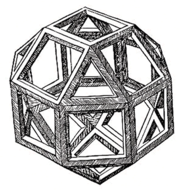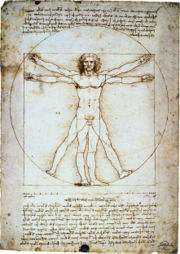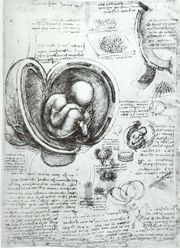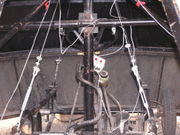Leonardo da Vinci
2007 Schools Wikipedia Selection. Related subjects: Artists; Engineers and inventors
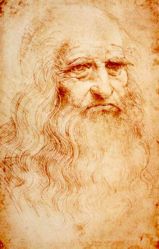 Portrait in red chalk, circa 1512 to 1515, widely (though not universally) accepted as an original self-portrait. |
|
| Born | April 15, 1452 Anchiano, Florence, Italy |
|---|---|
| Died | May 2, 1519 Amboise, Indre-et-Loire, France |
| Residence | Italy and France |
| Nationality | Italian |
| Field | Geometry, anatomy, mathematics, physics, visual arts, dynamics |
| Known for | Engineering, architecture, astronomy, paleontology, anatomy, painting |
| Religion | Roman Catholic Church |
Leonardo di ser Piero da Vinci ( April 15, 1452 – May 2, 1519) was an Italian polymath: architect, anatomist, sculptor, engineer, inventor, mathematician, musician, and painter. He has been described as the archetype of the " Renaissance man", a man infinitely curious and equally inventive. He is widely considered to be one of the greatest painters of all time.
Leonardo is famous for his realistic paintings, such as the Mona Lisa and The Last Supper, as well as for influential drawings such as the Vitruvian Man. He conceived of ideas vastly ahead of his own time, notably conceptually inventing a helicopter, a tank, the use of concentrated solar power, a calculator, a rudimentary theory of plate tectonics, the double hull, and many others. Relatively few of his designs were constructed or were feasible during his lifetime; modern scientific approaches to metallurgy and engineering were only in their infancy during the Renaissance. In addition, he greatly advanced the state of knowledge in the fields of anatomy, astronomy, civil engineering, optics, and the study of water ( hydrodynamics). Of his works, only a few paintings survive, together with his notebooks (scattered among various collections) containing drawings, scientific diagrams and notes.
Leonardo had no surname in the modern sense; "da Vinci" simply means "from Vinci". His full birth name was "Leonardo di ser Piero da Vinci", meaning "Leonardo, son of (Mes)ser Piero from Vinci."
Professional life
The earliest known dated work of Leonardo's is a drawing done in pen and ink of the Arno valley, drawn on 5 August 1473. It is assumed that he had his own workshop between 1476 and 1478, receiving two orders during this time.
From around 1482 to 1499, Ludovico Sforza, Duke of Milan , employed Leonardo and permitted him to operate his own workshop, complete with apprentices. It was here that seventy tons of bronze that had been set aside for Leonardo's "Gran Cavallo" horse statue (see below) were cast into weapons for the Duke in an attempt to save Milan from the French under Charles VIII in 1495.
When the French returned under Louis XII in 1498, Milan fell without a fight, overthrowing Sforza . Leonardo stayed in Milan for a time, until one morning when he found French archers using his life-size clay model of the "Gran Cavallo" for target practice. He left with Salai, his assistant and intimate, and his friend Luca Pacioli (the first man to describe double-entry bookkeeping) for Mantua, moving on after 2 months to Venice (where he was hired as a military engineer), then briefly returning to Florence at the end of April 1500.
In Florence he entered the services of Cesare Borgia, the son of Pope Alexander VI, acting as a military architect and engineer; with Cesare he travelled throughout Italy. In 1506 he returned to Milan, now in the hands of Maximilian Sforza after Swiss mercenaries had driven out the French.
From 1513 to 1516, he lived in Rome, where painters like Raphael and Michelangelo were active at the time, though he did not have much contact with these artists. However, he was probably of pivotal importance in the relocation of David (in Florence), one of Michelangelo's masterpieces, against the artist's will.
In 1515, Francis I of France retook Milan, and Leonardo was commissioned to make a centrepiece (a mechanical lion) for the peace talks between the French king and Pope Leo X in Bologna, where he must have first met the King. In 1516, he entered Francis' service, being given the use of the manor house Clos Lucé (also called "Cloux"; now a museum open to the public) next to the king's residence at the royal Chateau Amboise, where he spent the last three years of his life. The King granted Leonardo and his entourage generous pensions: the surviving document lists 1,000 écus for the artist, 400 for Count Francesco Melzi, (his pupil and allegedly one of the great loves of his life, named as "apprentice"), and 100 for Salai ("servant"). In 1518 Salai left Leonardo and returned to Milan, where he eventually perished in a duel. Francis became a close friend. Some twenty years after Leonardo's death, Francis told the artist Benevenuto Cellini that he believed that "No man had ever lived who had learned as much about sculpture, painting, and architecture, but still more that he was a very great philosopher."
Leonardo died at Clos Lucé, France, on 2nd May, 1519 (Romantic legend said that he died in Francis' arms). According to his wish, 60 beggars followed his casket. He was buried in the Chapel of Saint-Hubert in the castle of Amboise. Although Melzi was his principal heir and executor, Salai was not forgotten; he received half of Leonardo's vineyards.
Selected works
- The Baptism of Christ (1472–1475) – Uffizi, Florence, Italy (from Verrocchio's workshop; angel on the left-hand side is generally agreed to be the earliest surviving painted work by Leonardo)
- Annunciation (1475–1480) – Uffizi, Florence, Italy
- Ginevra de' Benci (c. 1475) – National Gallery of Art, Washington, D.C., United States
- The Benois Madonna (1478–1480) – Hermitage Museum, Saint Petersburg, Russia
- The Virgin with Flowers (1478–1481) – Alte Pinakothek, Munich, Germany
- Adoration of the Magi (1481) – Uffizi, Florence, Italy
- The Madonna of the Rocks (1483–86) – Louvre, Paris, France
- Lady with an Ermine (1488–90) – Czartoryski Museum, Krakow, Poland
- Portrait of a Musician (c. 1490) – Pinacoteca Ambrosiana, Milan, Italy
- Madonna Litta (1490–91) – Hermitage Museum, Saint Petersburg, Russia
- La belle Ferronière (1495–1498) – Louvre, Paris, France — attribution to Leonardo is disputed
- Last Supper (1498) – Convent of Sta. Maria delle Grazie, Milan, Italy
- The Virgin and Child with St. Anne and St. John the Baptist (c. 1499–1500) – National Gallery, London, UK
- Madonna of the Yarnwinder 1501 (original now lost)
- Mona Lisa or La Gioconda (1503-1505/1507) – Louvre, Paris, France
- The Madonna of the Rocks or The Virgin of the Rocks (1508) – National Gallery, London, UK
- Leda and the Swan (1508) - (Only copies survive — best-known example in Galleria Borghese, Rome, Italy)
- The Virgin and Child with St. Anne (c. 1510) – Louvre, Paris, France
- St. John the Baptist (c. 1514) – Louvre, Paris, France
- Bacchus (or St. John in the Wilderness) (1515) – Louvre, Paris, France
Science and engineering
Renaissance humanism saw no mutually exclusive polarities between the sciences and the arts, and Leonardo's studies in science and engineering are as impressive and innovative as his artistic work, recorded in notebooks comprising some 13,000 pages of notes and drawings, which fuse art and science. These notes were made and maintained through Leonardo's travels through Europe, during which he made continual observations of the world around him. He was left-handed and used mirror writing throughout his life. This is explainable by the fact that it is easier to pull a quill pen than to push it; by using mirror-writing, the left-handed writer is able to pull the pen from right to left and also avoid smudging what has just been written. He wrote in his diaries (journals) using mirror writing.
His approach to science was an observational one: he tried to understand a phenomenon by describing and depicting it in utmost detail, and did not emphasize experiments or theoretical explanation. Since he lacked formal education in Latin and mathematics, contemporary scholars mostly ignored Leonardo the scientist, although he did teach himself Latin. It has also been said that he was planning a series of treatises to be published on a variety of subjects though none were ever done.
Anatomy
Leonardo started to discover the anatomy of the human body at the time he was apprenticed to Andrea del Verrocchio, as his teacher insisted that all his pupils learn anatomy. As he became successful as an artist, he was given permission to dissect human corpses at the hospital Santa Maria Nuova in Florence. Later he dissected in Milan at the hospital Maggiore and in Rome at the hospital Santo Spirito (the first mainland Italian hospital). From 1510 to 1511 he collaborated with the doctor Marcantonio della Torre (1481 to 1511). In 30 years, Leonardo dissected 30 male and female corpses of different ages. Together with Marcantonio, he prepared to publish a theoretical work on anatomy and made more than 200 drawings. However, his book was published only in 1680 (161 years after his death) under the heading Treatise on painting. Leonardo also dissected cows, birds, monkeys, bears, and frogs, comparing their anatomical structure with that of humans.
Leonardo drew many images of the human skeleton, and was the first to describe the double S form of the backbone. He also studied the inclination of pelvis and sacrum and stressed that sacrum was not uniform, but composed of five fused vertebrae. He was also able to represent exceptionally well the human skull and cross-sections of the brain ( transversal, sagittal, and frontal). He drew many images of the lungs, mesentery, urinary tract, sex organs, and even coitus. He was one of the first who drew the fetus in the intrauterine position (he wished to learn about "the miracle of pregnancy") as well as the first to draw the human appendix. He often drew muscles and tendons of the cervical muscles and of the shoulder. He was a master of topographic anatomy. He not only studied human anatomy, he studied the anatomy of many other animals, as well. Leonardo could simultaneously draw with one hand and write with the other.
It is important to note that he was not only interested in structure but also in function, so he became a physiologist in addition to being an anatomist. He actively searched for models among those who had significant physical deformities, for the purpose of developing caricature drawings.
His study of human anatomy led also to the design of the first known robot in recorded history. The design, which has come to be called Leonardo's robot, was probably made around the year 1495 but was rediscovered only in the 1950s. It is not known if an attempt was made to build the device. He correctly worked out how heart valves eddy the flow of blood yet he was unaware of circulation as he believed that blood was pumped to the muscles where it was consumed. A diagram drawing Leonardo did of a heart inspired a British heart surgeon to pioneer a new way to repair damaged hearts in 2005.

Inventions and engineering
Fascinated by the phenomenon of flight, Leonardo produced detailed studies of the flight of birds, and plans for several flying machines, including a helicopter powered by four men (which would not have worked since the body of the craft would have rotated) and a light hang glider which could have flown. On January 3, 1496 he unsuccessfully tested a flying machine he had constructed.
In 1502, Leonardo da Vinci produced a drawing of a single span 720-foot (240 m) bridge as part of a civil engineering project for Ottoman Sultan Beyazid II of Istanbul. The bridge was intended to span an inlet at the mouth of the Bosphorus known as the Golden Horn. Beyazid did not pursue the project, because he believed that such a construction was impossible. Leonardo's vision was resurrected in 2001 when a smaller bridge based on his design was constructed in Norway. In May 2006, the Turkish government decided to construct Leonardo's bridge. It is expected to be finished by October 2006.
In 1490, he made a sketch that conceptualized a stepless continuously variable transmission (CVT). Modern variations of Leonardo's transmission concept are being used in some automobiles produced today. Continuously variable transmissions have been available in tractors, snowmobiles, and motorscooters for many years.
Owing to his employment as a military engineer, his notebooks also contain several designs for military machines: machine guns, an armoured tank powered by humans or horses, cluster bombs, a working parachute, a diving suit made out of pig's leather and a hose connecting to air, etc. even though he later held war to be the worst of human activities. Other inventions include a submarine, a cog-wheeled device that has been interpreted as the first mechanical calculator, and one of the first programmable robots that has been misinterpreted as a car powered by a spring mechanism. In his years in the Vatican, he planned an industrial use of solar power, by employing concave mirrors to heat water. While most of Leonardo's inventions were not built during his lifetime, models of many of them have been constructed with the support of IBM and are on display at the Leonardo da Vinci Museum at the Château du Clos Lucé in Amboise .
Notebooks
Leonardo kept notebooks throughout his life, in which he wrote daily, often in a private "backwards" or mirror-image handwriting. While the popular belief that he did this to keep some amount of secrecy may have some truth, the more plausible reason is that he did this naturally due to his left-handedness. He wrote about his sketches, inventions, architecture, elements of mechanics, painting ideas, human anatomy, grocery lists and even people that owed him money. These notebooks—originally loose papers of different types and sizes, distributed by friends after his death—have found their way into major collections such as the Louvre, the Biblioteca Nacional de España, the Biblioteca Ambrosiana in Milan, and the Victoria and Albert Museum and British Library in London. The British Library has put a selection from its notebook (BL Arundel MS 263) on the web in the Turning the Pages section. The Codex Leicester is the only major scientific work of Leonardo's in private hands. It is owned by Bill Gates, and is displayed once a year in different cities around the world.
Why Leonardo did not publish or otherwise distribute the contents of his notebooks remains a mystery to those who believe that Leonardo wanted to make his observations public knowledge. Technological historian Lewis Mumford suggests that Leonardo kept notebooks as a private journal, intentionally censoring his work from those who might irresponsibly use it (the tank, for instance). They remained obscure until the 19th century, and were not directly of value to the development of science and technology. In January 2005, researchers discovered the hidden laboratory used by Leonardo da Vinci for studies of flight and other pioneering scientific work in previously sealed rooms at a monastery next to the Basilica of the Santissima Annunziata, in the heart of Florence.
Personal life
Leonardo kept his private life secret. He claimed to have a distaste of physical relations: his comment that "the act of procreation and anything that has any relation to it is so disgusting that human beings would soon die out if there were no pretty faces and sensuous dispositions", was later interpreted by Sigmund Freud, in an analysis of the artist, as indicative of his "frigidity".
In 1476, while still living with Verrocchio, he was accused anonymously of sodomy with a 17 year-old model, Jacopo Saltarelli, a youth already known to the authorities for his sexual escapades with men. After two months of investigation he was acquitted, ostensibly because no witnesses stepped forward though others claim it was due to his father's respected position. For some time afterwards, Leonardo and the others were kept under observation by Florence's Officers of the Night - a Renaissance organization charged with suppressing the practice of sodomy, as shown by surviving legal records of the Podestà and the Officers of the Night.
Leonardo's alleged love of boys was a topic of discussion even in the sixteenth century. In "Il Libro dei Sogni" (The Book of Dreams), a fictional dialogue on l'amore masculino (male love) written by the contemporary art critic and theorist Gian Paolo Lomazzo, Leonardo appears as one of the protagonists and declares, "Know that male love is exclusively the product of virtue which, joining men together with the diverse affections of friendship, makes it so that from a tender age they would enter into the manly one as more stalwart friends." In the dialogue, the interlocutor inquires of Leonardo about his relations with his assistant, il Salaino, "Did you play the game from behind which the Florentines love so much?" Leonardo answers, "And how many times! Keep in mind that he was a beautiful young man, especially at about fifteen."
Gian Giacomo Caprotti da Oreno, nicknamed Salai or il Salaino ("The Little Unclean One" i.e., the devil), was described by Giorgio Vasari as "a graceful and beautiful youth with fine curly hair, in which Leonardo greatly delighted." Il Salaino entered Leonardo's household in 1490 at the age of 10. The relationship was not an easy one. A year later Leonardo made a list of the boy’s misdemeanours, calling him "a thief, a liar, stubborn, and a glutton." The "Little Devil" had made off with money and valuables on at least five occasions, and spent a fortune on apparel, among which were twenty-four pairs of shoes. Nevertheless, il Salaino remained his companion, servant, and assistant for the next thirty years, and Leonardo’s notebooks during their early years contain pictures of a handsome, curly-haired adolescent.
Il Salaino's name also appears (crossed out) on the back of an erotic drawing (ca. 1513) by the artist, The Incarnate Angel, at one time in the collection of Queen Victoria. It is seen as a humorous and revealing take on his major work, St. John the Baptist, (based on Salaino's appearance) also a work and a theme imbued with homoerotic overtones by a number of art critics such as Martin Kemp and James Saslow Another erotic work, found on the verso of a foglio in the Atlantic Codex, depicts il Salaino's behind, towards which march several penises on two legs. Some of Leonardo's other works on erotic topics, his drawings of heterosexual human sexual intercourse, were destroyed by a priest who found them after his death .
In 1506, Leonardo met Count Francesco Melzi, the 15 year old son of a Lombard aristocrat. Melzi himself, in a letter, described Leonardo's feelings towards him as a sviscerato et ardentissimo amore ("a deeply passionate and most burning love"). Salai eventually accepted Melzi's continued presence and the three undertook journeys throughout Italy. Melzi became Leonardo's pupil and life companion, and is considered to have been his favourite student.
Though Salai was always introduced as Leonardo's "pupil", the artistic merit of his work has been a matter of debate. He is credited with a nude portrait of Lisa del Gioconda, known as Monna Vanna, painted in 1515 under the name of Andrea Salai. The other portrait of Lisa del Gioconda, the Mona Lisa was bequeathed to Salai by Leonardo, a valuable piece even then, as it is valued in Salai's own will at £200,000.
Both of these relationships follow the pattern of eroticized apprenticeships which were frequent in the Florence of Leonardo's day, relationships which were often loving and frequently sexual. (See Historical pederastic couples.) Besides them, Leonardo had many other friends who are figures now renowned in their fields, or for their influence on history. These included Cesare Borgia, in whose service he spent the years of 1502 and 1503. During that time he also met Niccolò Machiavelli, with whom later he was to develop a close friendship. Also among his friends are counted Franchinus Gaffurius and Isabella d'Este, whose portrait he drew while on a journey which took him through Mantua.
Vegetarianism
It is apparent from the works of Leonardo and his early biographers that he was a man of high integrity and very sensitive to moral issues. His respect for life led him to being a vegetarian for at least part of his life. The term " vegan" would fit him well, as he even entertained the notion that taking milk from cows amounts to stealing. Under the heading, "Of the beasts from whom cheese is made," he answers, "the milk will be taken from the tiny children." . Vasari reports a story that as a young man in Florence he often bought caged birds just to release them from captivity. He was also a respected judge on matters of beauty and elegance, particularly in the creation of pageants.
It is possible that Leonardo da Vinci embraced vegetarianism at a young age, and unverified claims have been made that he remained so for the entire duration of his life.
Johannite heresy
It has been the subject of much speculation whether da Vinci was an orthodox Christian or whether he was a heretic. Many conspiracy theorists believe that he was "infected" with the Johannite heresy, that is he regarded not Jesus Christ but John the Baptist as the real Christ. This subject has also been the source for many best-selling books in recent times.
Cultural depictions of Leonardo da Vinci
With the genius and legacy of Leonardo da Vinci having captivated authors and scholars generations after his death, many examples of "da Vinci fiction" can be found in culture and literature. As of 2006, the most prominent example is Dan Brown's novel The Da Vinci Code (2003), which is concerned with Leonardo's role as a supposed member of a secret society called the Priory of Sion.


